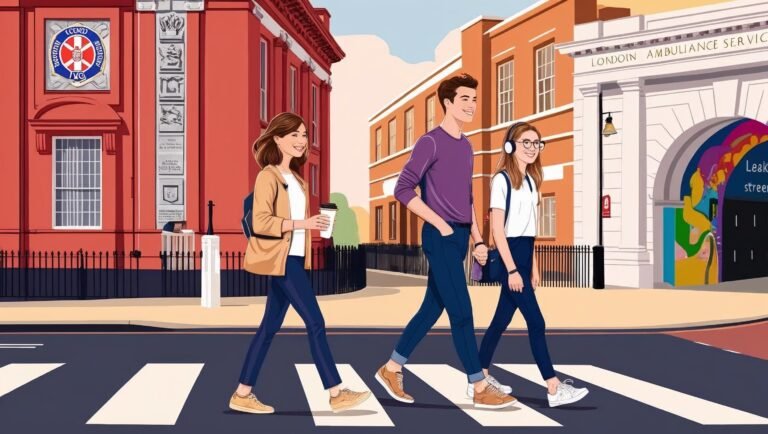A personal ride-along with my 19-year-old daughter, my neuro-divergent teen son, and the yellow card reader that keeps us moving.
1 | The Three-Beep Epiphany
It’s 07:28 at Waterloo. My daughter is balancing an oat-milk latte like an Olympic torch, my son is narrating Minecraft strategies at auction-house speed, and I’m convinced we’ll miss the 07:32 unless the ticket machines discover warp drive. Instead, we each touch a bank card to the yellow reader. Beep-beep-beep. Gates glide open, coffee survives, conversation flows, and three broad smiles light the platform. In that instant, London’s contactless TAP system turns a routine commute into a tiny family victory.
2 | From Experiment to Everyday
London flirted with bank-card tapping on buses in 2012; by 16 September 2014 the scheme covered every Tube, DLR, tram and Overground gate in one audacious drop — TfL’s promise: “an easier and more convenient way to pay for travel.” Ridership embraced it fast: more than one million journeys were clocked in the first nine days, and by April 2018 half of all pay-as-you-go Tube and rail trips already used contactless cards or phones. Today, taps comfortably outnumber Oyster swipes on most routes.
3 | The Nuts-and-Bolts Joy
A tap at the start and another at the end is all it takes. Behind the scenes TfL bundles every ride you make from 04 : 30 to 04 : 29 the next day into a single overnight charge and then checks whether you’ve hit a daily cap or the fixed Monday-to-Sunday cap.
In 2025 the Zone 1-2 ceiling is £8.90 a day and £44.70 a week, so by Thursday our fares freeze and the kids cheer “free rides!” for the rest of the week. Almost any payment tool works: Visa, Mastercard, Amex, V Pay, most overseas cards, plus Apple Pay, Google Pay, Fitbit, Garmin, Samsung watches and more. Stick to one card or device, though—mixing phone-in and plastic-out confuses the system and torpedoes your caps. The same TfL page also reminds you to watch your battery and keep rival cards out of “card clash” range; nothing bonds strangers on a platform like watching someone argue with a wallet full of competing chips.
4 | Field-Testing with Teenagers
Since embracing TAP our mornings feel chore-free. My daughter now glides past dormant ticket machines, latte arm steady, mind unburdened. For my son, the predictable green flash and crisp beep reduce sensory overload; he’s re-branded the Tube as “real-life fast travel.” I relish the extra two-minute buffer that used to vanish in ticket queues—small but blissful when you’re herding caffeine, teenagers and deadlines. Even accessibility wins: clearly signposted step-free interchanges and that sci-fi travelator at Waterloo mean fewer escalator meltdowns and more playful “this is like Portal!” commentary.
5 | Where the Shine Dulls (a Little)
Perfection has potholes. Overseas relatives discovered their bank slaps a 3 % foreign-transaction fee on TfL’s daily lump-sum—no fault of TfL, but suddenly the “cheap” ride felt pricier in New Zealand dollars. Concession discounts (student, senior, Railcard) still can’t live on bank cards, so my daughter’s thrifty friends grudgingly keep an Oyster for half-price fares. The infamous card clash comedy routine—tapping a stuffed wallet eight times—remains a crowd-pleaser, and if your phone battery dies between tap-in and tap-out the gate will demand a maximum fare and a sheepish chat with staff. Finally, the weekly cap resets every Monday; long-weekend visitors rarely travel enough days to trigger it, so a traditional 7-Day Travelcard can still win for awkward mid-week start dates.
6 | How London Stacks Up
- New York’s OMNY copied London’s homework in 2019 and now frees riders after they hit $34 (≈ 12 rides) within any Monday–Sunday window—excellent, but there’s still no daily cap.
- Paris is phasing out paper carnets, yet still pushes most travellers toward a Navigo card or Android-only phone solution; a plain Visa tap works only on a handful of pilot gates, so spontaneity is limited.
- Tokyo’s famously efficient network has run on smartcards for decades, but a true credit-card tap only entered public trials in December 2024, covering Toei and Keikyu lines from Haneda Airport—great for tourists, but still a sliver of the megalopolis.
- Against that backdrop, London’s “any card, any gate, capped fares” remains the gold (or should we say yellow) standard.
7 | Verdict from Carriage 215
For a caffeine-fuelled young adult, a neurodivergent code wizard, and their logistics-loving mum, contactless TAP shrinks London from sprawling metropolis to pocket-size playground. It saves minutes, pounds and a generous slice of cognitive bandwidth. Which city’s tap-and-go system thrilled—or thwarted—you? Did OMNY’s weekly cap rescue your wallet, or did Paris leave you longing for London’s yellow pads? Share your tales, tips and triumphs below; together we’ll keep the transit conversation moving faster than a Northern Line sprint.
Star Rating: ★★★★½
Joy Factor: 🌞🌞🌞🌞🌞 – five sunbursts for that Friday-morning moment when the weekly cap kicks in and every subsequent ride feels cheekily free.


